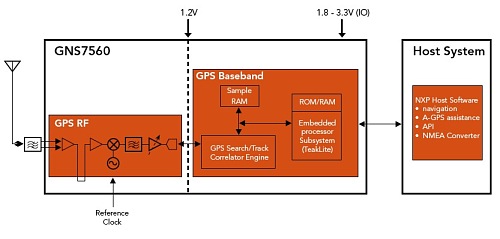GPS chip minimizes size, power consumption
Feb 6, 2008 — by LinuxDevices Staff — from the LinuxDevices Archive — 5 viewsNXP Semiconductors is now sampling a GPS chip claimed to be the industry's smallest and lowest-powered. The GNS7560 requires only four external connections, offers Linux drivers, and uniquely, saves power by altering sensitivity and tracking based on signal strength, multipath, and velocity, according to the company.
Built using a 90-nanometer process, the GNS7560 comes in Wafer Level Chip Scale Packaging (WLCSP) and ChipArray Ball Grid Array (CABGA) packages, measuring 3.6 x 2.4 x 0.6 mm and 6 x 4 x 0.8 mm respectively. NXP says that the WLCSP version is the smallest GPS chip available.
Also touted by NXP are the GNS7560's low power consumption and high sensitivity. Power consumption is said to be under 15 mW, in 1Hz (map updates every second) tracking mode.
Acquisition sensitivity is rated at -158 dBm in assisted GPS (A-GPS) and autonomous hot-start modes, and -160 dBm when tracking. Proprietary “DynaTrack” technology rapidly adjusts to challenging environments such as urban canyons or indoor settings, where competing GPS receivers would drop out, the company claims.

NXP GNS7560 block diagram
(Click to enlarge)
The GNS7560 uses a hosted architecture, shifting the navigation software that isn't realtime-critical to the host system's processor. As illustrated in the block diagram above, the only connections required are for RF and clock inputs, the serial interface to the host, and power. Because of high sensitivity, the receiver works with low-cost passive antennas, including dipole antennas implemented as PCB traces, according to NXP.
Features and specifications cited by NXP for the GNS7560 include:
- Sensitivity:
- -158 dBm acquisition sensitivity in A-GPS and autonomous hot-start modes
- -160 dBm tracking sensitivity
- -158 dBm acquisition sensitivity in A-GPS and autonomous hot-start modes
- Power consumption — <15 mW in 1Hz tracking mode)
- Extremely low external component count and PCB size
- DynaTrak advanced tracking and multipath algorithms
- Hosted architecture with broad high-level and real-time kernel OS support
- Supports GSM, W-CDMA, and CDMA control plane A-GPS
assistance data standards - Supports SUPL user plane A-GPS assistance data
- Exceeds 3GPP and 3GPP2 performance requirements
- Supports all common GPS and cellular handset reference
frequencies (10 to 50 MHz) - Supports ultra-low-cost PCB dipole antennas
- UART and SPI host interfaces
- Operating temperature — -40 to +85 deg. C
- Dimensions:
- WLCSP — 3.6 x 2.4 x 0.6 mm
- CABGA (6 x 4 x 0.8 mm, 0.65-mm pitch)
- WLCSP — 3.6 x 2.4 x 0.6 mm
The GNS7560 is offered with drivers for Linux, Windows CE, Windows Mobile, and a variety of real-time kernels, according to NXP. The company did not provide pricing or volume availability information for the chip, but said it is sampling now.
This article was originally published on LinuxDevices.com and has been donated to the open source community by QuinStreet Inc. Please visit LinuxToday.com for up-to-date news and articles about Linux and open source.